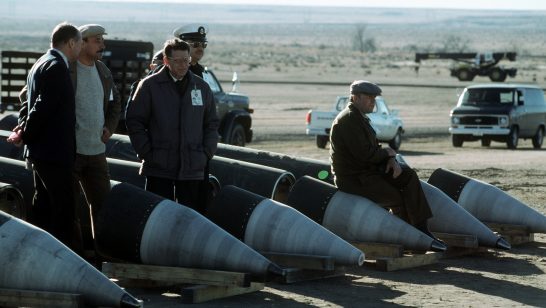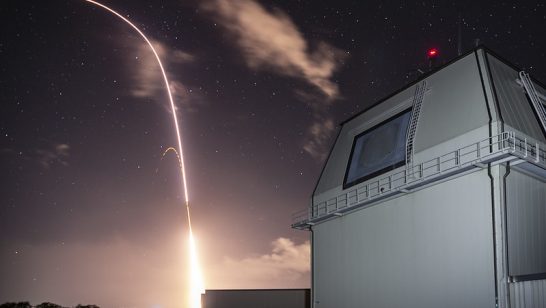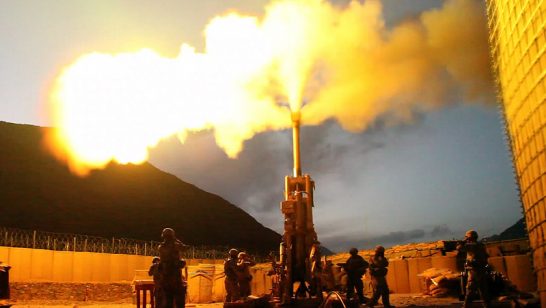
It may not be the first thing you might think about when seeing Russian missile bombardments of Ukraine, but a disarmament treaty has denied Russia thousands more missiles that it could have used in its current war. Thanks to Presidents Ronald Reagan and Mikhail Gorbachev, Russian forces attacking Ukraine have not been able to use ground-to-ground ballistic and cruise missiles of ranges from 500-5,500 km because this entire category of weapons was scrapped under the 1987 Intermediate Forces (INF) Treaty. Although this treaty was cancelled by President Trump in 2019 following consistent Russian violations and Russian concerns over US compliance, only one Russian missile type that apparently violated the Treaty exists and, as it has a nuclear-only role, it has not, so far, been used in Ukraine. When the Treaty was implemented, thousands of the then Soviet Union’s most modern missiles were – along with their American equivalents – crushed, sawn or blown up.
A positive legacy of the INF Treaty is that Russia was not able to field new generations of ground-to-ground conventional missiles or non-nuclear variants of the Cold War stocks with ranges from 500-5,500 km, apart from the system mentioned above. A huge proportion of Russian munitions used in Ukraine are vintage Soviet systems. With conventionally armed INF missiles of similar vintage with ranges over 500 km, Lviv and other centres in Western Ukraine could have been devastated. Russia has had to use limited numbers of missiles built for air and sea launch and manned bombers to attack targets deeper than 500 km from Russian (and Belarusian) territory.
The process that produced the extraordinarily effective INF Treaty provides important guidance for a renaissance in disarmament in the present century. Then, despite an intense confrontation, successful agreements were reached to avert Armageddon. Alarmed by the Soviet invasion of Afghanistan and new Soviet missiles – notably the SS-20 – NATO embarked on a twin-track “arm and negotiate” strategy in 1979. Eight years later, after missile deployments, the INF Treaty was signed, implementing the demand of Western anti-nuclear campaigners and Eastern dissidents for “No Cruise, No Pershing, No SS-20s”. The Reagan Administration, under public pressure and informed by a key defector from the Soviet Union, picked up the movements’ demands. They did not imagine that the Soviet Union would accept this Zero Option, let alone under Michael Gorbachev, take it further with missiles of shorter range. He also called for all weapons under 500 km to be scrapped, but NATO refused, arguing that this would damage its deterrent. It is missiles in this category that are raining down on Ukraine today.
“Negotiate from Strength” is a powerful argument in diplomacy. With Henry Kissinger arguing for diplomacy to prevent war between the US and its allies with China and Russia, a new disarmament negotiation strategy is sorely needed. Fortunately, the US and its allies already enjoy a more than 10:1 superiority in military spending over Russia and five times that of China. Unless Western taxpayers have been badly served, this spending has translated into effective technologies despite rhetoric over hypersonics and Putin’s doomsday nuclear torpedoes. Indeed, US Allies in NATO and the Pacific are now deploying conventional missiles for their fighter jets, able to reach Moscow and Beijing from outside Russian and Chinese territory.
That such supremacy does not appear to soothe the concerns of notable analysts points to the risks of miscalculation so apparent in Putin’s “Special Military Operation” and how far our strategies rely on luck. Discussions of a nuclear attack by Putin on Ukraine, of a Western response, and even the future of Russia are devoid of any discussion of the aftermath, let alone of weapons controls.
Short of a civilisation ending nuclear war, any nuclear explosions will produce intense pressure for their ban and, from some, for greater weaponry. Any Russian collapse will require an international response to safeguard its nuclear stocks in conditions far more extreme than that of the early 1990s that were met by the Nunn-Lugar threat reduction initiative.
Where to start? The West and other nuclear powers argue that nuclear disarmament is necessarily connected to non-nuclear arms, not least given the contemporary mixing of nuclear and non-nuclear systems and the devastation caused by conventional forces, so evident in Ukraine.
Picking up the INF Treaty mantra of a Zero Option, civil society needs to seek a global zero on missiles of all kinds down to a range of, say, 150 km. The Council on Foreign Relations’ Alton Frye made a proposal for zero ballistic missiles (ZBM) in 1992, and in 2007 France, Russia, the US and the UK circulated a non-paper in Geneva proposing a Global INF Treaty on land-based ballistic and cruise missiles of 500-5,500km range from a Russian initiative. It had the drawback of removing key strategic systems from China and regional powers and did not address naval and air-launched missiles.
Frye argues that removing missiles increases warning times and, therefore, stability as verification is now a simpler matter than for nuclear, chemical and biological weapons. Universality is highly attractive, the majority of states do not have such weapons at present and Russia and China have an interest in removing capabilities that they see as technically if not politically threatening. Advances in kinetic technologies, including hypersonic weapons and fast, stealthy, accurate cruise missiles, require inclusion to make the proposal viable. Implementing a Zero Missiles initiative would be a boon to taxpayers, and universality would be welcome in the international arena.
While the idea of Zero Missiles for global security may never take off, common arguments against it are unconvincing. The circumstances are never ‘right’ for disarmament; fear is the key motivation if the 1960s and 1980s experience is any guide. Compliance will always be a challenge; however, the range of agreements forged in fear, ABM, SALT, START, INF, OSCE (CSBMs, CFE, Open Skies) worked well for decades. Open Source Investigations in the Age of Google is a forthcoming book building on a webinar series that presents the step change in effective early warning of violations.
Zero Missiles is part of a new global initiative on disarmament being debated at the University of London. This Strategic Concept for the Removal of Arms and Proliferation draws on past and present operative treaty text to envisage a renaissance in arms control and disarmament using the demonstrable successes of the global architecture of arms control and disarmament. The SCRAP concept sets out paths to WMD elimination and proliferation prevention; and controls and confidence-building measures for the major armaments of armies, navies and air forces, as well as for small arms and light weapons. A special meeting of the UN on disarmament, which has been agreed upon but has been in limbo for thirty years, needs activating to create a dynamic process.
Leadership worthy of the name is marked by a willingness to step in and change paradigms. In this case, one can start with a simple question: Why is there no weapons control process equivalent to the global response to the climate crisis?
The opinions articulated above represent the views of the author(s) and do not necessarily reflect the position of the European Leadership Network or all of its members. The ELN’s aim is to encourage debates that will help develop Europe’s capacity to address the pressing foreign, defence, and security policy challenges of our time.
Image: Wikimedia, Ministry of Defence of the Russian Federation



